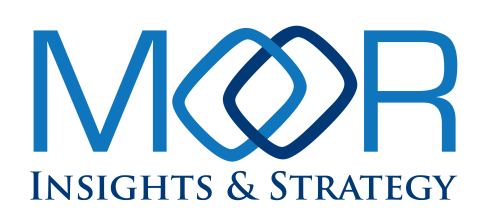
The Moor Insights & Strategy team hopes you had a great weekend!
Last week, Anshel Sag was at IFA Berlin, where his insights were featured during the Qualcomm press conference. This week, Patrick, Melody, Matt, and Robert will be in Las Vegas for Oracle CloudWorld and Netsuite SuiteWorld. Will Townsend will be in London for Connected Britain, where he’ll be moderating a panel. Jason Andersen will be in Austin for JFrog swampUP 24.
Will is hosting a webinar with Zayo, “What’s Next for Your Network’s Foundation?” on September 17. It’s free to register to hear Will’s insights on the future of networks.
Our MI&S team published 10 deliverables:
- 5 Forbes Articles
- 2 MI&S Research Notes
- 1 MI&S Blog Post
- 2 Podcasts
Over the last week, our analysts have been quoted multiple times in top-tier international publications with our thoughts on Intel, NVIDIA, Zoom, and charging for AI.
Patrick Moorhead appeared on Yahoo! Finance and CNBC to discuss NVIDIA stock and the DOJ subpoena over possible antitrust violations. Melody was on the Big UC News Show to discuss Zoom AI, Slack and Box integration, and more.
MI&S Quick Insights
YouTube recently announced new AI detection tools intended to protect creators from unauthorized use of their likenesses. There has been concern about the ease with which AI can misuse someone’s face, voice, or other attributes. The new YouTube tools can detect when AI-generated content has copied a creator’s appearance or voice without permission.
The new policy, backed up by YouTube’s tools and commitment to protecting IP and personal rights, is appropriate because fake images, fake porn, and other videos are easily created, and almost anyone can do it with readily available AI tools. I believe the new detection methods will allow creators to more easily police their own digital properties to protect their reputations and brands from damage.
The bulk of—and most impressive part of—our exposure to AI began only a couple of years ago with ChatGPT. In the short time between then and now, AI has evolved rapidly, even though our understanding of AI’s inner workings hasn’t matched its functional evolution. According to a new research paper by Google DeepMind researchers, machine psychology provides a fresh way to understand how AI models work.
Traditionally, AI’s core functionality and power are based on complex neural network designs. Machine psychology doesn’t examine how an AI model reacts to inputs or what its output reveals. Instead of the inner step-by-step path through the model, machine psychology focuses on understanding the “behavior” of AI as it responds to commands and questions. Terms like “learning” or “reasoning ” have roots in human psychology, and applying them to AI can be confusing and meaningless. It is like calling AI intelligent even though it doesn’t have human-like understanding or consciousness yet.
Machine psychology is important because it helps us recognize and understand AI’s sophisticated behaviors and abilities beyond simple data processing. It will require long-term research to understand AI behavior over time, predict future developments, and ensure that AI remains safe and aligned with human objectives. Machine psychology is a significant step and necessary step to better understand AI. If you are interested in learning more, click here for the paper by Google DeepMind.
YouTube recently announced new AI detection tools intended to protect creators from unauthorized use of their likenesses. There has been concern about the ease with which AI can misuse someone’s face, voice, or other attributes. The new YouTube tools can detect when AI-generated content has copied a creator’s appearance or voice without permission.
The new policy, backed up by YouTube’s tools and commitment to protecting IP and personal rights, is appropriate because fake images, fake porn, and other videos are easily created, and almost anyone can do it with readily available AI tools. I believe the new detection methods will allow creators to more easily police their own digital properties to protect their reputations and brands from damage.
The bulk of—and most impressive part of—our exposure to AI began only a couple of years ago with ChatGPT. In the short time between then and now, AI has evolved rapidly, even though our understanding of AI’s inner workings hasn’t matched its functional evolution. According to a new research paper by Google DeepMind researchers, machine psychology provides a fresh way to understand how AI models work.
Traditionally, AI’s core functionality and power are based on complex neural network designs. Machine psychology doesn’t examine how an AI model reacts to inputs or what its output reveals. Instead of the inner step-by-step path through the model, machine psychology focuses on understanding the “behavior” of AI as it responds to commands and questions. Terms like “learning” or “reasoning ” have roots in human psychology, and applying them to AI can be confusing and meaningless. It is like calling AI intelligent even though it doesn’t have human-like understanding or consciousness yet.
Machine psychology is important because it helps us recognize and understand AI’s sophisticated behaviors and abilities beyond simple data processing. It will require long-term research to understand AI behavior over time, predict future developments, and ensure that AI remains safe and aligned with human objectives. Machine psychology is a significant step and necessary step to better understand AI. If you are interested in learning more, click here for the paper by Google DeepMind.
Last week I got the chance to tune into Dell’s AIOps strategy and products. For context, we are now about one year out from Dell’s acquisition of Moogsoft. I was impressed with how Dell is pragmatically tackling the challenges of increasingly complex IT ops structures. Instead of trying to be all things to all people, Dell focuses its efforts on its own infrastructure via its Infrastructure Observability platform, where it clearly can add the most value. To put it another way, instead of trying to do everything itself, Dell is adding a different sort of value to customers’ operations requirements via a clever partnering and integration approach. For application observability, Dell has chosen to tightly integrate with IBM’s Instana platform. For cross-platform integration and alerting, Dell Incident Management is the new name for Moogsoft. It may be just enough flexibility without sacrificing Dell’s own AI management solution that is optimized for its hardware.
Speaking of observability, this will be a hot topic for different companies over the next few months, with many new products and announcements in the pipeline. While I cannot speak to anything specific yet, enterprises need to understand a couple of things. Crucially, the scope of observability is changing in both breadth and depth. Observability tools are leveraging better analytics and AI tools to provide new—deeper and more connected—views of the environment. A good example of this is IBM Concert, IBM’s application- and service-centric viewpoint. On the breadth front, we are seeing a wider range of observability tools across the IT landscape. A good example of this is VMWare Cloud Foundation 9, which was announced last week. This flood of new products and capabilities will require more in-depth reviews to ensure that enterprises are able to (a) not pay for things they do not need and (b) make sure the tooling will align with increasingly complex environments.
Anecdotally, usage of AI code assistants seems to be trending upward. As I cover this space and have great enthusiasm for AI as a developer aid, I’ve seen a big uptick in both LinkedIn posts and Reddit entries on this topic. Some but not all were positive. Given the newness of the technology and how people are migrating up the AI learning curve (including me—see this post from last week), mixed results are not surprising. But it is notable, and a trend I will continue to watch.
While tuning into VMWare Explore a couple of weeks ago, I saw the initial signs of a transformation effort for the company. And while it has been hard to hear about colleagues and customers that have been impacted by Broadcom’s acquisition, it does appear that VMWare is working hard to regain its footing. I see parallels between the steps VMWare is taking and those of other companies that have successfully transformed—or that, like SAP, are currently undergoing a transformation. It prompted me to sit down and consider what it takes for big tech companies to weather disruptive market events. You can read my thoughts in this new post on our site.
HPE released its quarterly earnings, and the numbers were impressive. Overall, revenue came in at $7.7 billion, up 10% year over year. GreenLake ARR grew at a 39% YoY clip, with over 3,000 new customers in the quarter (for nearly 37,000 GreenLake customers total). And server revenue came in at $4.3 billion—a 35% YoY increase. As we saw with other server vendors, HPE’s business is recognizing considerably more revenue due to the AI boom (the company’s AI business was roughly $1.3 billion—a 39% sequential increase). It is clear that the focus on driving adoption of HPE technologies and services through AI is paying off.
As with other OEMs, we are also seeing that the AI game is considerably lower-margin. While these AI servers are selling at a higher ASP, the margins appear to be going to the chipmakers who are providing AI acceleration. Strategically, it’s important for HPE (and all OEMs) to win as much business in this market as they can—despite the lower margins. Establishing itself as the AI solution of choice while this market is still nascent will lead to more, margin-rich business as inferencing begins to dominate the AI landscape. This will impact the entire HPE portfolio. (Keep an eye on the intelligent edge market over time.)
One area of concern is the company’s 7% shrink in its hybrid cloud business. This business includes server, storage, the recently announced private cloud, resiliency, and GreenLake Flex. While the company didn’t provide a breakout of contributions, I suspect storage is contributing to this decline. Despite HPE talking about numbers trending in the right direction, its storage business has been relatively flat to negative over the past few quarters (as has its largest competitor’s—Dell also reported soft storage numbers).
Here’s what I think is going on: the high end of the storage market is moving to AI and high-performance-specific storage vendors (VAST, Weka, DDN, etc.). Also, I believe companies including Pure Storage (up 10% YoY) and NetApp are taking their fair share of the commodity AI-storage market. Likewise, I believe these storage vendors are taking a share of mid-range enterprise storage through deployment-driven purchases. Lenovo has also done well in this “commodity storage” market.
In other earnings news, Broadcom reported mixed results. Its revenue for the quarter came in at $13.07 billion, with $7.25 billion attributed to semiconductors and $5.8 billion attributed to software. Fueling these numbers were AI-related silicon and the contribution of VMware to the software portfolio.
On the software front, VMware’s number is a little more impressive considering that, post-acquisition, Broadcom sold off two considerable contributors (the Horizon end-user computing division and the Carbon Black security unit). Countering these strong numbers was the rest of Broadcom’s software portfolio, which saw a considerably smaller 4% YoY growth. This is to be expected, as the other contributors include what was Symantec and mainframe software solutions (previously CA). While I see VMware’s contribution as a big win for Broadcom, I believe CEO Hock Tan has the right perspective on this. At the recent VMware Explore event, he said the real measure of success with VMware will not be in short-term licensing deals and revenue, but the consumption of its new VCF 9 private cloud platform. (I published a detailed analysis of VCF 9 on Forbes.) While licensing revenue is transactional, consumption of the full capabilities of VCF 9 is sticky—meaning very long-term.
On the silicon front, Broadcom suggested that AI acceleration was carrying the business, while non-AI-related silicon had “bottomed out.” Further, the company expects to see the non-AI-related business rebound and accelerate through Q4. What Broadcom is suggesting is what I’m seeing across the industry: AI is fueling the tech industry at the moment, while non-AI-related business is more sluggish.
What to make of the U.S. government going after NVIDIA for antitrust violations? This is a tough one to sort through. Does NVIDIA have a monopoly? Yup. Is this monopoly due to anti-competitive behaviors? This is where it gets murky. NVIDIA’s CUDA software platform makes it difficult for non-NVIDIA silicon providers to be competitive. CUDA is also almost 20 years old and only became popular because NVIDIA silicon was so much better than the competition that developers chose to use it. If AMD was as successful in designing and building silicon after its ATI acquisition, CUDA would not be a lockout architecture today. In fact, we see what happens when competitors do create competitive silicon: AMD’s most recent quarter saw it far exceed expectations with the MI300—and the company raised its forecast.
I was with AMD when the company sued Intel for anti-competitive behavior. It was a legitimate gripe. OEMs were being compensated to limit Opteron (the AMD server CPU) in terms of portfolio, positioning, and go-to-market. Not only did Intel compensate AMD, it also paid heavy fines around the globe.
(Let me be clear that I don’t mean to suggest that AMD is tied in any way to the actions of the U.S. government. I mention them simply because they are now NVIDIA’s closest competitor and because of my experiences during the Intel antitrust activities.)
Is NVIDIA deploying similar tactics? Or has it simply designed better GPUs over the years and is now benefiting from that success? I don’t know the answer to that question. But if NVIDIA hasn’t done anything wrong, the U.S. government is actively stifling innovation and the success that comes along with that innovative spirit. NVIDIA made a lot of bets far ahead of the market, and those bets have paid off.
The analyst community lost a wonderful soul with the recent passing of Brian Gong of Pure Storage (and formerly Cisco). Analyst relations folks are, by nature, social creatures. The best ones are funny, warm, and genuinely interested in us as analysts and people. Even by this measure, Brian was a cut above others. He will be sorely missed for his warmth, wit, and genuinely gentle spirit. To the good folks at Pure Storage—we wish you well during this difficult time.
Observe, Inc. provides an observability platform that unifies telemetry data from distributed applications, enabling faster, more cost-effective troubleshooting. Integrating with over 250 data sources and cloud services like AWS and Kubernetes, the platform is built on Snowflake and uses a usage-based pricing model focused on data storage and querying. Observe aims to modernize monitoring by replacing traditional log analytics and infrastructure tools.
I mention this because Observe has a new release for its Observe Agent, taking a further step in the observability game by adopting OpenTelemetry as the standard for data collection. Given how packed this market is with seasoned players, it’ll be interesting to see what sets Observe apart from the crowd. Patrick Moorhead and I recently connected with the team at Observe; watch for more details about the tech behind the platform and how Observe plans to carve out its niche.
Smartsheet is reportedly in talks to be acquired with private equity firms, including Vista Equity Partners and Blackstone. The reports of the acquisition talks resulted in a nearly 10% rise in Smartsheet’s shares. In its Q2 2025 earnings, Smartsheet reported that revenue increased by 17% YoY to $276.4 million. Smartsheet currently serves 85% of the Fortune 500 with its cloud-based enterprise solutions for project management and collaboration. Smartsheet management declined to comment on the buyout talks, but Reuters reported that the company hired an investment bank in June to explore interest from PE firms. Overall, M&A activity has slowed, creating pent-up demand in the private equity universe, according to a recent report from PwC.
Meta has joined the steering committee of the Coalition for Content Provenance and Authenticity. The C2PA, as a standards body, focuses on establishing ways to verify the origin and history of digital content, an increasingly vital task in the face of rising misinformation and the proliferation of AI-generated media.
There’s a certain irony in Meta promoting digital authenticity. Meta’s platforms, especially Instagram, have been criticized for fostering environments where users often present idealized (and heavily filtered) versions of their lives, contributing to feelings of inadequacy and inauthenticity, among other things. Meta’s business model relies heavily on collecting user data and targeted advertising, practices that can feel intrusive and manipulative, further eroding trust and authenticity. So, it can seem contradictory for Meta to now champion digital authenticity when its platforms have arguably played a role in creating the opposite.
Whether its efforts are perceived as genuine remains to be seen. In a digital world where distinguishing real from synthetic media is increasingly challenging, Meta’s active participation in the C2PA alongside other industry leaders represents a crucial step towards establishing a more transparent and trustworthy online environment. This move could influence how different platforms handle content verification, potentially shaping the future of how we consume and interact with information online. Ultimately, Meta’s deeper involvement with the C2PA is a promising indicator of a proactive approach to addressing the complexities and challenges brought about by the rise of AI and the spread of misinformation.
Data and AI were central themes at this year’s Amazon Web Services (AWS) summit in New York. Dr. Matt Wood, AWS VP for AI products, noted, “Customers are able to apply generative AI to understand and leverage existing data in new and exciting ways.” At the event, AWS introduced new features to its three-layer GAI stack, enhancing AI infrastructure, models, and applications. These expansions aim to make AI and data analytics more accessible for large enterprises, small businesses, and startups. The summit also highlighted how Nasdaq utilizes AI, as well as the broader impact of AWS’s generative AI offerings across different industries. My latest Forbes article provides insights on AWS’s recent summit.
HPE recently announced its Q3 earnings, and it was a tale of two product portfolios, despite double-digit top-line revenue growth. To no one’s surprise, server revenue was up 35% based on strong AI systems demand, while networking revenue was down 23%. I expect that the company’s quarterly performance is a result of customer prioritization of computing infrastructure, but networking could rebound in the future with the imminent close of the Juniper Networks acquisition.
Capgemini is acquiring Syniti to broaden its data management expertise and strengthen its SAP project capabilities. With a team of more than 1,200 specialists, Syniti brings a wealth of experience in data transformation and management across industries including life sciences, aerospace, manufacturing, retail, and automotive.
This acquisition positions Capgemini to better support RISE with SAP implementations, especially in data migration to SAP S/4HANA. Both companies recognize that successful digital transformation hinges on clean, reliable data. By integrating Syniti’s expertise, Capgemini could offer clients a smoother path for data migrations and governance, as well as more efficient use of their data during ERP transitions.
Next week marks an exciting time as Oracle rolls out two of its big annual events. I will be at Oracle’s CloudWorld and NetSuite’s SuiteWorld conferences starting September 8, diving into the latest innovations in AI, automation, and more. AI and machine learning have an increasing influence on ERP systems, especially those related to demand forecasting, supply chain management, quality control, shipping, preventive maintenance, data intelligence, and process automation. I’m looking forward to seeing what’s new from Oracle and NetSuite in these areas. If you have any questions or want to set up a meeting, feel free to reach out.
Zoho announced the launch of Zoho Payments, a unified payment solution that allows businesses to accept payments via various methods (cards, UPI, net banking) directly within their business applications. Zoho Payments offers businesses flexibility in receiving payments from customers. Businesses can tailor the options—such as invoice e-mails, payment links, dedicated payment pages, and a secure client portal—so customers can choose how they want to pay. Early access customers in the U.S. can receive payments in 135 currencies, and the solution ties to all of Zoho’s finance ecosystem, including Zoho Books, Inventory, Billing, Invoice, and Checkout. This solution, which is now also available for early access in India, promises to provide faster payouts and streamlined dispute management.
The long-awaited and much-anticipated Thread 1.4 update is now available. This new version is significant because Thread is the low-power device mesh network used by Matter, and it’s already present in most homes as a standard feature of smart speakers and hubs.
Users frequently encounter five big problems when adding new devices and border routers to existing Matter/Thread networks, and this new version addresses all of them.
- Different border router brands (smart speaker, hubs) can now share credentials and join existing Thread networks instead of creating new networks.
- Users can connect multiple border routers over Wi-Fi and Ethernet to cover large buildings and campuses.
- Users can install Thread devices without physical access to the device or its QR code.
- Thread now supports network diagnostics that simplify troubleshooting.
- Thread devices can directly communicate with cloud-based services.
Thread Group announced these enhancements at CES in January. Completing these complex new features in seven months is impressive progress for a standards body. For instance, multiple product ecosystems sharing the same Thread network required hyperscalers to collaborate on secure credential sharing. Those discussions must have been interesting. The good news is that 1.4 primarily affects border routers, while individual Matter/Thread devices are backward-compatible. Hence, the update should not delay the availability of new Matter devices. And many existing border router products are software upgradeable to 1.4, so I expect a slew of new Matter products at CES in January. Please refer to Thread’s 1.4 features white paper for technical details.
Quantum Brilliance (QB) and Oak Ridge National Laboratory (ORNL) announced a collaborative effort to integrate QB’s room-temperature diamond-based quantum computing technology with ORNL’s high-performance computing systems. Quantum Brilliance was founded in Australia in 2019. It specializes in room-temperature diamond quantum accelerators. With funding supplied by the Australian Capital Territory Government, Quantum Brilliance wants to make quantum technology more accessible so it can be integrated into everyday devices and advanced computing systems.
The collaborative objective is to explore the effectiveness of parallel and hybrid quantum computing. Parallel quantum computing uses multiple quantum processors working together, while hybrid computing combines quantum and classical processors. It is hoped that the combination of enhanced computational capabilities will solve problems beyond the reach of classical computing alone.
We are getting closer to a powerful supercomputer that will integrate AI, HPC, and quantum technologies.
Zscaler is the latest company to suffer a stock value decline despite posting solid financial results for its most recent quarter. Sales were up 30%, billings up 27%, and deferred revenue up 32%. However, pressure on profitability and a softer revenue outlook triggered a 17% stock value decline last week. It proves that Wall Street will be satisfied only when expectations for both current but future financial performance are met.
SportAI recently closed a $1.8 million seed-funding round, allowing it to continue developing its technology and expand its reach. SportAI uses artificial intelligence to improve sports performance. Its platform provides sports-technique coaching, commentary, and analysis using machine learning, computer vision, and biometric technology. It caters to coaches, training facilities, broadcasters, sports equipment brands, and retailers. SportAI’s platform works with various video sources, eliminating the need for specific hardware and manual tagging—and thereby making video analysis more scalable and technically accessible. This also makes it more commercially accessible to more people, because previous versions of this type of performance analysis were costly and, therefore, mainly limited to professional athletes or larger companies.
AI is transforming both the business world and sports, with UEFA’s use of AI in the Champions League draw as a prime example. As the competition moved to a more complex 36-team league format, the traditional manual draw system, where teams were pulled from bowls, became impractical. The complexity of factors, such as preventing teams from the same country from meeting too often, made it too challenging for manual handling. AI software now manages these details, improving accuracy and reducing the risk of human error.
Concerns arose after a technical mishap in the draw for the 2021–22 tournament forced a redo. With AI now in place, UEFA has improved its ability to manage the process smoothly, but fans who worry about transparency and the potential for manipulation remain skeptical.
This shift in sports mirrors the broader impact AI is having across industries. AI is already transforming areas like customer service and data analysis in business, making operations more efficient. In sports, AI is enhancing efficiency and changing how complex logistics are managed. While scrutiny around transparency and misuse is present in both fields, the benefits of AI in reducing errors are evident. However, humans must always stay involved in these processes to ensure appropriate oversight.
Honeywell and Cisco are collaborating on an AI-powered solution that adjusts building systems based on real-time occupancy data to reduce energy consumption. The joint effort uses Cisco Spaces to collect occupancy and environmental data and Honeywell Forge Sustainability+ for Buildings to improve energy efficiency. Room temperatures, lighting, and ventilation are adjusted based on occupancy, leading to automated building operations, optimized energy use, improved employee comfort, and reduced greenhouse gas emissions.
This collaboration supports Honeywell’s aim to reduce buildings’ environmental footprint and aligns with its focus on automation and energy transition. Cisco also supports the initiative with its Country Digital Acceleration program, a worldwide effort involving governments and businesses to create equitable and safe societies using responsible and cutting-edge technology. Building owners are prioritizing energy management because of hybrid working policies and lower occupancy. These factors and other challenges are putting pressure on owners to operate buildings efficiently and minimize resource waste.
AT&T recently struck a new deal with Nokia; on the surface, many interpret it as an olive branch, given the operator’s alignment with Ericsson for open RAN infrastructure last year. Nokia has a long history of success in fiber optics, and the latest announcement will provide AT&T with platforms that will upgrade and expand its massive fiber network over a five-year period. Nokia’s Lightspan platform is extremely flexible and can provide symmetrical speeds at 10G, 25G, 50G, or 100G. It is potentially a lucrative opportunity for Nokia, one that the company desperately needs to keep its financial performance on stable footing.
Forbes Articles Published
- Broadcom’s Hock Tan Declares ‘The Future Is Private’ At VMware Explore – Patrick Moorhead
- Embracing AI To Augment, Not Replace, The Status Quo – Jason Andersen
- Say Ahh To AI: How The Tongue Can Reveal Hidden Health Issues – Paul Smith Goodson
- AWS Summit New York 2024: Democratizing Data And AI – Robert Kramer
Research Notes Published
- Qualcomm Scores with Snapdragon’s Manchester United Sponsorship — Melody Brue
- How SAP and VMware Are Now Leaning into Cloud Disruption – Jason Andersen
Blog Posts Published
Podcasts Published
MI&S DataCenter Podcast (Will Townsend, Paul Smith-Goodson, Matt Kimball)
Ep. 29 of the MI&S Datacenter Podcast – We’re Talking Zscaler, AI, Broadcom, HPE, xAI, Dell
Six Five (Patrick Moorhead)
The Six Five Ep 230: Special Guest, NVIDIA, VMware Explore, Salesforce, Dell, Pure Storage, HP
Don’t miss future MI&S Podcast episodes! Subscribe to our YouTube Channel here.
Citations
Intel / Lunar Lake / Anshel Sag / Business World
Intel Unveils Lunar Lake Processors, Aiming to Reclaim AI Computing Leadership
Intel / Lunar Lake / Anshel Sag / PC Mag
‘Lunar Lake’ Leaves the Launch Pad: Intel Unveils Core Ultra 2 Laptop Chips at IFA | PCMag
Intel / Stock / Patrick Moorhead / Fierce Electronics
While seeking cheers for its new PC chip, Intel stock tanks
NVIDIA / DOJ Suit / Patrick Moorhead / CNBC
Nvidia doesn’t have a history of abusing monopolistic power, says Moor insight’s Patrick Moorhead
NVIDIA / DOJ Suit / Patrick Moorhead / Eastinitial
Here’s why Nvidia’s aggressive sales tactics are in the DOJ’s crosshairs
NVIDIA / Patrick Moorhead / EconoTimes
NVIDIA Denies DOJ Subpoena Amid Stock Drop, Pledges Full Cooperation with Regulators – EconoTimes
NVIDIA / DOJ Suit / Patrick Moorhead / Yahoo! Finance
How Nvidia could land in legal hot water
NVIDIA / Patrick Moorhead/ Fortune
Here’s why Nvidia’s aggressive sales tactics are in the DOJ’s crosshairs
NVIDIA / DOJ Suit / Patrick Moorhead / Tweak Reviews
Nvidia shares weakened by possible lawsuit
NVIDIA / DOJ Suit / Patrick Moorhead / WCCF Tech
NVIDIA Denies Receiving A Subpoena From The DOJ, Says It Is “Happy” To Answer All Questions
NVIDIA / Stocks / Patrick Moorhead / Yahoo! Finance
Nervous about Nvidia? Here are some other stocks to consider
Zoom / AI / Melody Brue / UC Today
Should UC And Collaboration Businesses Charge For AI?
New Gear or Software We Are Using and Testing
- Cisco Desk Pro (Melody Brue)
- OnePlus Buds Pro 3 (Anshel Sag)
Events MI&S Plans on Attending In-Person or Virtually (New)
Unless otherwise noted, our analysts will be attending the following events in person.
- Oracle Cloud World, September 9-12, Las Vegas (Melody Brue, Robert Kramer)
- JFrog swampUP 24, September 9-11, Austin (Jason Andersen)
- Connected Britain, September 11-12, London (Will Townsend)
- Connected Britain panel moderation, September 11-12, London (Will Townsend)
- Snowflake Industry Day 2024, September 12 (virtual) (Robert Kramer)
- Snap Partner Summit, September 17, Santa Monica (Anshel Sag)
- Zayo Network Transformation webinar moderation, September 17 (Will Townsend)
- Salesforce Dreamforce, September 17-19, San Francisco (Patrick Moorhead) (virtual – Jason Andersen, Melody Brue, Robert Kramer)
- Intel Innovation, September 23-26 — EVENT CANCELED
- HP Imagine, September 24, Palo Alto (Anshel Sag)
- Meta Connect, September 25, San Jose (Anshel Sag)
- Verint Engage, September 23-25, Orlando (Melody Brue)
- Infor Annual Summit, September 30-October 2, Las Vegas (Robert Kramer)
- Oracle Cloud World, September 9-12, Las Vegas (Melody Brue, Robert Kramer)
- JFrog swampUP 24, September 9-11, Austin (Jason Andersen)
- Connected Britain, September 11-12, London (Will Townsend)
- Connected Britain panel moderation, September 11-12, London (Will Townsend)
- Snowflake Industry Day 2024, September 12 (virtual) (Robert Kramer)
- Snap Partner Summit, September 17, Santa Monica (Anshel Sag)
- Zayo Network Transformation webinar moderation, September 17 (Will Townsend)
- Salesforce Dreamforce, September 17-19, San Francisco (Patrick Moorhead) (virtual – Jason Andersen, Melody Brue, Robert Kramer)
- Intel Innovation, September 23-26 — EVENT CANCELED
- HP Imagine, September 24, Palo Alto (Anshel Sag)
- Meta Connect, September 25, San Jose (Anshel Sag)
- Verint Engage, September 23-25, Orlando (Melody Brue)
- Infor Annual Summit, September 30-October 2, Las Vegas (Robert Kramer)
- Fem.AI Summit, Menlo Park, October 1 (Melody Brue)
- Microsoft Industry Analyst Event, Burlington, Mass, October 2 (Melody Brue)
- LogicMonitor, Austin, October 2-4 (Robert Kramer)
- Teradata, October 7-10, Los Angeles (Robert Kramer)
- Zoomtopia, San Jose, October 8-9 (Melody Brue)
- Embedded World NA, Austin, October 8-10 (Bill Curtis)
- MWC Americas and T-Mobile for Business Unconventional Awards event judge, October 8-10, Las Vegas, October 8-10, Las Vegas (Will Townsend)
- AWS GenAI Summit, October 9-10, Seattle (Jason Andersen, Robert Kramer)
- AdobeMAX, October 14-16, Miami (Melody Brue)
- Lenovo Global Analyst Summit & Tech World, October 14-17, Bellevue, WA (Matt Kimball, Paul Smith-Goodson, Anshel Sag)
- IBM Analyst Summit, October 16-18, New York City (Matt Kimball, Robert Kramer)
- Snapdragon Summit, Maui, October 20-24 (Will Townsend)
- WebexOne, October 21-24, Miami (Melody Brue)
- RISC-V Summit, October 22-23 — virtual (Matt Kimball)
- Cisco Partner Summit, Los Angeles, October 28–30, 2024 (Robert Kramer)
- SAP SuccessConnect, October 28-30 – virtual (Melody Brue)
- Red Hat Analyst Day, October 29 (Jason Andersen — virtual)
- GitHub Universe, October 29-30, San Francisco (Jason Andersen)
- 5G Techritory, October 30-31, Riga (Will Townsend)
- Dell Tech Analyst Summit, November 6-8, Austin (Matt Kimball, Anshel Sag, Paul Smith-Goodson)
- Apptio TBM Conference, November 4-5, San Diego (Jason Andersen)
- IBM, November 6-8, New York City (Paul Smith-Goodson)
- Fyuz, November 11-13, Dublin (Will Townsend)
- Veeam Analyst Summit, November 11-13, Scottsdale, AZ (Robert Kramer)
- Box Analyst Summit, November 12-13, San Francisco (Melody Brue)
- Microsoft Ignite, November 18-22, Chicago (Robert Kramer – virtual, Will Townsend – virtual)
- Super Computing, November 18-22, Atlanta (Matt Kimball)
- NTT R&D Forum, November 19-23, Tokyo (Will Townsend)
- AWS re:Invent, December 2-6, Las Vegas (Robert Kramer, Will Townsend, Jason Andersen, Paul Smith-Goodson)
- T-Mobile Analyst Summit, December 9-10 (Anshel Sag)
- Marvel Industry Analyst Day, December 10, Santa Clara (Matt Kimball)
Subscribe
Want to talk to the team? Get in touch here!





























































































